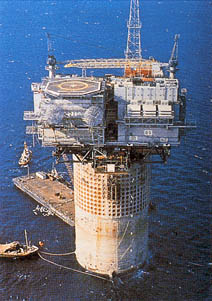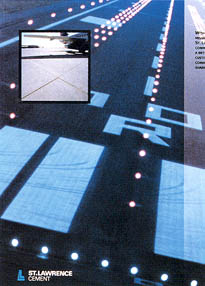 |
An overview of St. Lawrence Cement's Mississauga plant, the largest cement plant in Canada. |
In addition to playing a major role in the production and supply of cement and concrete to Ontario’s construction industry, St. Lawrence Cement has another story to tell. It is one that takes place behind the scenes where innovative technological achievements and ground-breaking research have led to new hope in addressing some environmental concerns.
St. Lawrence Cement began operations in 1954 in Quebec but soon expanded into Ontario with the addition of its plant in Clarkson ( Mississauga), Ontario, in 1956. Today St. Lawrence Cement is recognized as the largest cement producer in eastern Canada and the northeastern United States. The company also ranks as the second largest cement manufacturer in the country.
Its products are found in a number of installations throughout Ontario. From the newly constructed Terminal 3 building at Pearson International Airport to major highways such as the 427 and 401 in Toronto, from banks and apartment buildings to refineries to generating stations, St. Lawrence Cement’s products are part of everyday life for most Ontario residents.
With 5 cement plants,
33 cement distribution terminals, 58 ready-mixed concrete plants, 27 quarries
and sand pits and 2 construction companies, St. Lawrence Cement is divided
into three separate operational divisions: Quebec and the Maritimes, Ontario,
and the United States. Serving over 15 million Canadians and 60 million
Americans, the company accounts for more than 25 percent of the total capacity
of the cement produced in Canada.
 |
An overview of St. Lawrence Cement's Mississauga plant, the largest cement plant in Canada. |
Since its opening, St. Lawrence Cement has continued to grow and has now developed into a full, vertically integrated group by acquiring aggregate quarries and plants for manufacturing concrete products and materials.
However, it is the com-pany’s Mississauga operation that has established a worldwide reputation as a technological leader and outstanding corporate citizen. It is here that, on several occasions, history was made in the industry.
From the day of its official opening, the Mississauga plant was lauded for its technological capabilities in waste reclamation. Its new dust-collection equipment between the kilns and the stack was designed to collect and feed the waste dust back into the firing end of the kilns for reburning.
When the facility was expanded in 1968, its new preheater kiln was the first large preheater kiln ever installed in North America. In fact, at that time it was the largest in the world.
In the mid-1970s pioneering efforts of an outstanding technical staff led to even further recognition worldwide.
The technical people at the company saw the potential of cement kiln technology for the utilization of organic waste for fuel. Since temperatures in the kilns can reach as high as 2100 degrees celsius with a retention time of six seconds, technicians saw the kiln as an ideal process for the destruction of waste. In 1976 St. Lawrence Cement in Mississauga began ground-breaking research — with the full support of the Ontario Ministry of the Environment, Environment Canada, and the U.S. Environment Protection Agency — into the destruction in its kilns of chlorinated organic wastes.
The results of these
tests have influenced waste management efforts on a global scale. Plants
in Europe and the U.S. have drawn upon the technology to the extent that
there are now literally hundreds of cement operations used as waste destruction
sites worldwide. Cement companies in Canada are following the same trend,
examining waste destruction efforts for tires and municipal solid waste.
  |
| 1. St. Lawrence Cement is supplying the cement to produce the concrete for this immense oil drilling platform to be used for the Hibernia Oil project off the coast of Newfoundland. 2. St. Lawrence Cement's affiliate construction company, Dufferin Construction, has been the main contractor for the construction of runways at Toronto's Pearson International Airport. |
Other significant developments include the utilization of kiln waste dust in three areas: neutralization and consolidation of acid waste at tanneries, steel plants, and metal plating; extraction of potassium and sulphates for chemical use; and pelletization as fertilizer filler and for Kitty Litter. The company has also developed the utilization of industrial wastes in cement production in four major applications: petro coke for partial fuel replacement; pelletized Blast Furnace Slag as addition to concrete; waste lubricating oil as fuel; and silica fume addition for production of high strength concrete used in construction of oil drilling platforms.
These research efforts have been well recognized by industry experts. In 1978 the Chemical Institute of Canada awarded the company its highly prized Environ-mental Improvement Award.
St. Lawrence Cement’s commitment to improving the quality of life for its employees and the communities its serves is also reflected in its ongoing financial and moral support to local health, cultural, and education programs. For example, the company developed an extensive training course for Junior Achievement called the Business in Action (BIA) Workshop. Funded and organized by St. Lawrence Cement, this two-day training program has become a much anticipated and highly coveted annual prize for outstanding Junior Achievers.
St. Lawrence Cement was also a key contributor to the Mississauga YMCA project and has funded the efforts of numerous historical and conservation groups in the area. It has been publicly recognized for many of its programs in support of local environmental efforts. In 1975 the SOTAS (Save Our Trees and Streams) Award was presented to the company for its landscaping at the Mississauga plant, while the reclamation of an old quarry in Milton into a landscaped park has received international recognition.
Community relations have always been important to St. Lawrence Cement. Information sessions, public meetings, news-letters, and open houses reinforce the company’s extensive communication efforts and led to its presentation by the Mississauga Board of Trade of the 1989 Outstanding Business Achievement Award.
While continuing to provide improved products for the construction industry, St. Lawrence Cement will retain its ongoing commitment to environmental and community issues. Through continued research and technological advancements and the forward-thinking corporate philosophy that has characterized its past endeavours, St. Lawrence Cement promises to maintain its role as an industry achiever –in more ways than one.